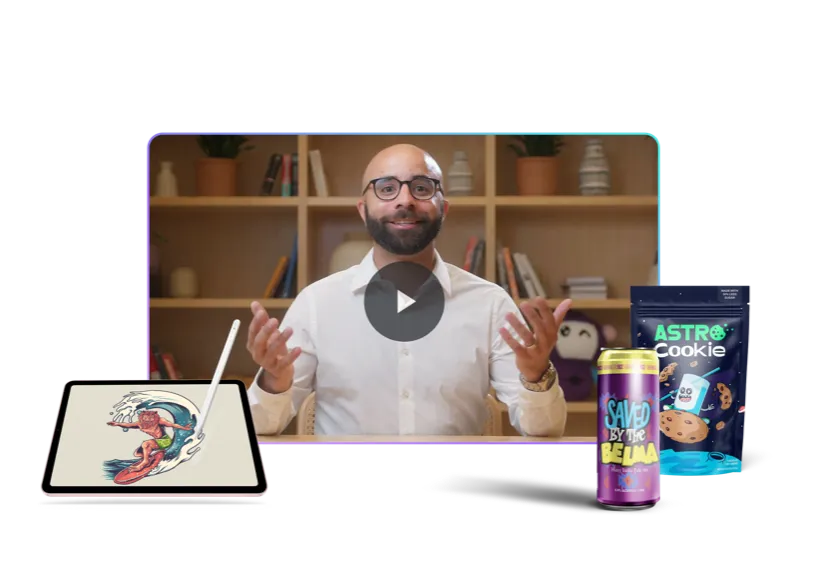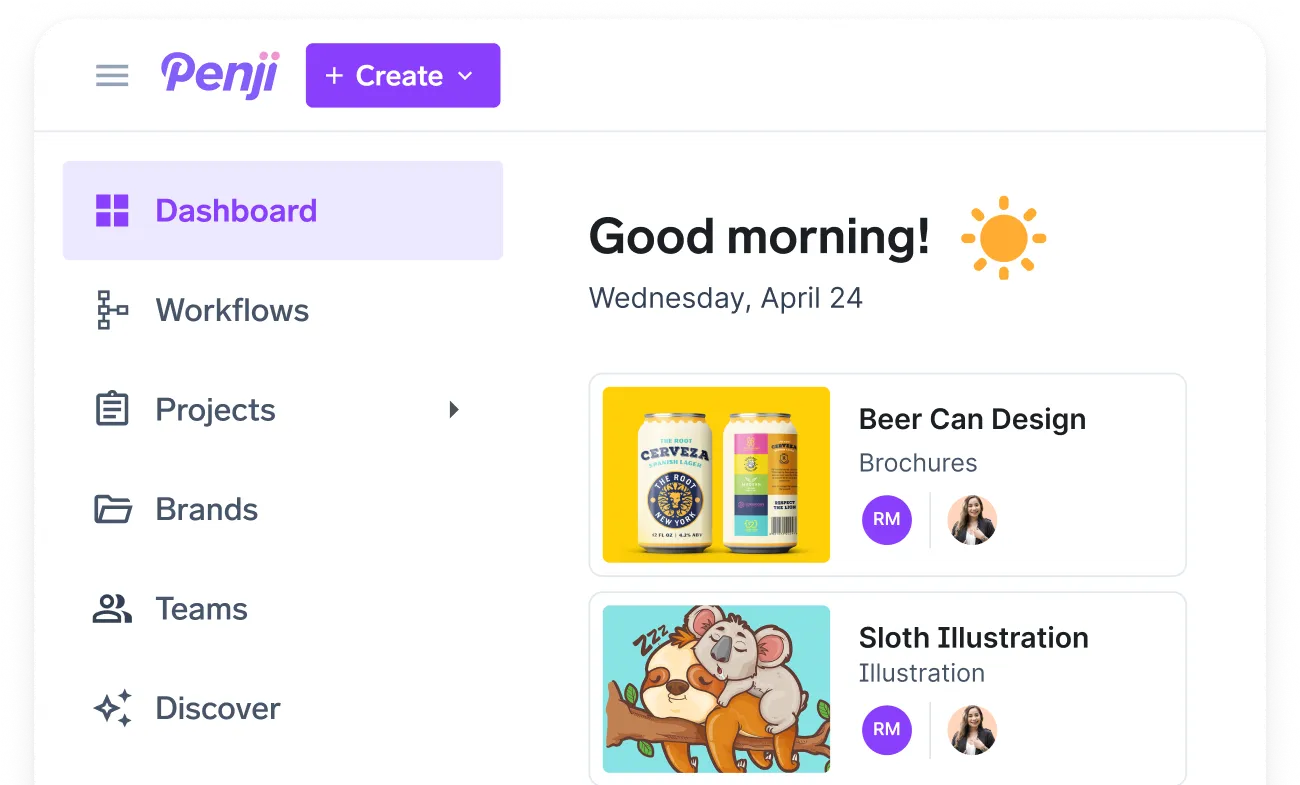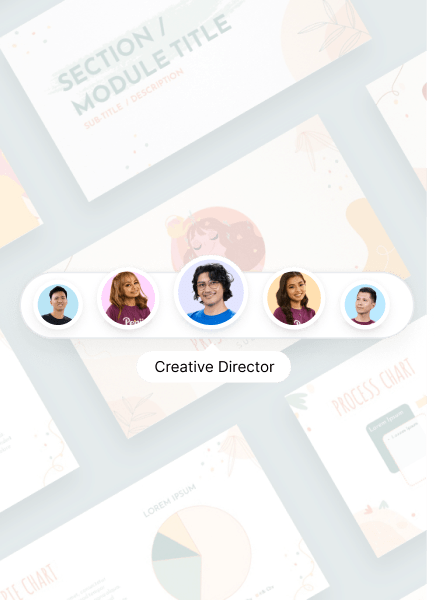![[Fully Managed] Charlie Riley from OneScreen Ep. 157](https://penji.co/wp-content/uploads/2025/07/BLOG-IMAGE-Charlie-Riley.jpg)
Daniella: Hello everybody. Welcome to the first 100 podcast. This is where we explore the journey of entrepreneurs, business owners, agency leaders, and so many other people as they share with us the strategies, the challenges, and the triumphs that led them to secure those first 100 customers, those first 100 followers, first 100. I’m very excited. Today, we have with us a very special guest called Charlie Riley.
Hi, Charlie. How are you?
Charlie: I’m good. How you doing?
Daniella: I’m doing great. Very happy to have you on the show. Before we start, I wanted to give you a space to tell our viewers and our listeners a little bit about yourself. For people who don’t know about you, who don’t know about OneScreen, please, the floor is yours.
About Charlie Riley and OneScreen
Charlie: Sure. Yeah. Thanks for having me. My name is Charlie Riley and I’m the first head of marketing for OneScreen. We are a measurable out of home advertising platform, so we help brands, B2B and B2C direct to consumer. We help them use real life ads to complement their digital advertising. The best part about that is it’s measurable.
So as most marketers are used to measuring paid search or paid social can be measured. And usually one of the misperceptions a lot of marketers have. So it’s a great way to extend brands. It’s a great way to use for EDM campaigns for direct sales. So yeah, we’ve had a lot of fun with helping a wide range of marketers realize how out-of-home should fit into their omnichannel marketing mix.
Daniella: Very interesting. And a little bit about yourself. How did you end up with OneScreen? Specifically was there like, how has your journey been towards this moment?
Charlie: Yeah, so I joined a few months ago through kind of just a marketing connection who was involved with the organization and we were just chatting about a couple of marketing tactics and she said, you know, this sounds like an interesting company that aligns with a lot of what you’ve done. I’ve been the first marketing hire for several brands from startup to $20 million revenue company.
So I’ve kind of worn different hats across my career in a marketing sense. This was an intriguing opportunity because one, the team as I met them and got to know who they were, just an excellent group of people that had some amazing backgrounds and were solving some interesting problems. And it’s fun. I get to sell marketing services to marketers.
And there’s a fun part about the analytical side from a measurement standpoint, but the creative element of out of home and the ability to have a blank canvas to tell some fun brand stories. So to me, it was intriguing. And yeah, it was something that I thought this is a fun opportunity to work with a really good team that’s solving a fun problem for other marketers.
Unique Challenges in Out-of-Home Marketing
Daniella: Definitely. Yeah. So I actually had some questions for you about this whole thing. What do you think since you joined obviously in the months that you’ve been at OneScreen? Have you noticed the unique challenges that your company is facing in solving problems for marketers? You know, it’s a very specific space, this sort of out of home side, right? What do you think are those problems?
Charlie: Yeah, I mean, for us, it’s probably like any other company at our stage, it’s identifying and finding the right mix of customers and helping them solve their problems. And we work with and this is a great opportunity. And it’s also one of those areas that lends to maybe not being able to hone in specifically in one area, which is good because we’ve seen a wide range of companies and marketers come to us to solve some of their problems.
They are either sponsoring a conference and they just either they don’t have a really great booth location, they want to stand out a little bit more. So there’s a lot of great activation, like mobile trucks, street teams, almost like PR slash field marketing executions that we can do from an out of home standpoint. Other companies, they’ve got it’s an ABM play for them.
They’ve got 20 top customers and they’re struggling to get in front of the right decision makers. We can do billboards right outside of where their executives live, work and play. We strategically map that out to figure out parts of where they are or we can even have trucks or billboards outside of their office headquarters with a message specific to them.
So it really it’s been fun to figure out all the different use cases that people have. And one of the challenges for us as a marketing company selling to marketers is we just got a really great story to tell about mobile measurement, because that’s the one area that I think a lot of marketers just assume that you can’t do with a billboard or a transit ad, but you can.
And we use geofencing, we use a couple of different other tactics used QR codes and we cookie sites so that we can track sales lift, we could track conversion lift. So there’s a number of ways that it’s actually a measurable channel, just like digital channels are. So yeah, our challenge and really my challenge as a marketer is trying to help tell that story to the right audiences, so they understand you start to see some head nods from other marketers and say, Oh, that’s interesting, tell me more.
And so we have no shortage of great stories. It’s just getting in front of them like every other company is trying to do.
Measuring Out-of-Home Campaign Success
Daniella: Yeah, definitely. And I think like what you said about sort of being able to track the success of a billboard or an ad or something is a little bit harder than, I guess, less straightforward. Like you said. So what are these methods that you guys use to measure engagement, measure success of a certain marketing campaign or a certain marketing effort? What are those key metrics and those KPIs that you guys are looking for or you’re advising brands to focus on? And how are you facilitating this for them?
Charlie: Yeah, So every campaign we run, it’s a performance campaign. I mean, some of them are brand campaigns. They want to tell a story. They have a product launch. But it’s a performance channel, just like paid search, paid social, any other performance. So what we do is we strategize where a marketer will come to us and tell us their need or their problem and we build a solution around that.
And so it’s not necessarily just to sell them a bunch of billboards. It’s okay, you’re trying to accomplish X, we use 30 some data sources to build a plan to deliver the impressions that they need with that. And how we can measure that is everyone has a mobile device. So there’s a thing called a mobile ID that’s attached to that.
And so it’s anonymous basically profile of who you are based on certain demographics. So we don’t know exactly who you are as an individual, but what we can do is we can geofence a location around each ad that we place. And so with those mobile IDs, when someone ID, we can register that someone with that mobile ID has viewed an ad and it’s in a vicinity we call a view.
That view shared. So we put an area around that ad we can then track that to see if they had converted on a website. They go and purchase something as a DTC brand. Do they purchase a shirt, shoes? And then we can track that by cookieing at the checkout page? Or did they download something that was the main goal?
Did they sign up for a webinar? Did you ask them to go to a certain landing page? Whatever the goal is, we can track that measurement all the way through from that exposure to the ad through to whatever that conversion, whatever the conversion that that a brand wanted. So and then we can take that information, that list of mobile IDs that’s anonymous and hand that to the marketing team or we can do that for them to retarget so they can use that information to retarget ads back to them.
So they’re extending the exposure that they have from an out of home campaign that someone’s seeing in real time. They can’t turn those ads off. They complement the digital ads very well, but then they can extend those digital ads after the fact. So there’s a couple of ways that we can do improvement or measurement on that. But it really depends on what the goal is of each campaign.
And we tailor the planning and the measurement towards that.
Daniella: Well, yeah. So it’s like you basically tailor it to what every single brand that you’re working with is looking for, right?
Charlie: Yeah. So like I said, some brands, it’s a brand play. They want just extra exposure in a high concentration locations of where their audience might be spending time. And we help them figure out where that is or it might be an ABM play where, like I said, they’ve got a top 50 account list. They’ve been struggling to get penetration with those.
The buyers there will map out where those executives might be spending time past that they might be taking to work. And we can either purchase billboards along the path there. We could put mobile trucks with digital ads around those. We could do programmatic digital out of home ads. So it really depends on what the execution is. If they’re doing a conference sponsorship, they might do a street team that’s handing out coffee outside of that conference, or just even if they want to do a customer appreciation campaign.
We’ve done that for some customers where they’re buying billboards, but they’re showing their main customers and that’s a great retention tool. So it really depends on what their goal is. But out of home fits into pretty much any one of those executions. It really just depends on where they want to do it and maybe how they want to do it.
The Digital vs. Out-of-Home Marketing Debate
Daniella: So actually I had a question about, you know, you guys do a lot of out-of-home and I’ve spoken to a lot of people within the marketing space who tend to start to want to pull away from that. And a lot of them are focusing on very digital faced marketing, right? Like I’ve spoken to a lot of companies who want to just focus on social media and content marketing, and it seems like that’s the most popular thing.
I even spoke to a person who told me, you know, just like straight up, like, I don’t want to do any billboards, I don’t want to do any ads on the street because I don’t think it’s worth time anymore. And here you guys are sort of innovating on that traditional marketing sense. What is your opinion on this sort of change that has been happening within the marketing industry?
And do you agree that, like, you know, this kind of marketing is dead or do you think that it’s the new wave of like complementing each other? Where do you stand on it?
Charlie: Yeah, I mean, I obviously wouldn’t have come here if I didn’t believe in out-of-home as one piece. I think for marketers to discount or just to disregard one channel and maybe that’s, you know, I’d be curious, the marketers are talking about that based on the measurement that they saw the planning that they actually had if they were placed in the right locations or maybe they went directly to a vendor and they only had exposure to the inventory that that vendor had, what we’re seeing is digital ad fatigue.
And so every person in the world is inundated with a million emails a day, they’re just kind of like zoning out as you’re scrolling through social. I’m just like overabundance of digital ads and that fatigue is real and people zone out on those they just they subconsciously it’s just they start paying attention to that and that’s where out-of-home complements those channels.
I don’t know many marketers that pick one channel. That’s the only thing they do. The nice part about adding out of home or social or, you know, experiential, whatever that might be, is that you’re putting the whole mix together because you know, someone might not spend all their time on their mobile device or they might not spend all their time on certain social channels where you might assume that they’re there, but they’re still active.
They’re going out to get groceries, they’re going out, they’re going to the gym, they’re doing things in the real world. And those are ads you cannot turn off. You can’t cookie. You know, there’s no cookies there. There’s no like tracking pixels that can’t be added to emails so that the images don’t render. You can’t turn those things off.
And so the benefits of what we provide to complement digital ads is that we plan each campaign accordingly. So if someone, a marketer comes to us and says, Here’s our ICP here, so we’re trying to talk to, we can use a lot of data sources to find the right inventory to be in front of those audiences.
We wouldn’t recommend someone to only move their media budget out of home that kind of be ridiculous to do that is the same way as we wouldn’t recommend someone to do that only digital they all complement each other. And we’ve seen some really great results with paid search campaigns, our SEO campaigns that when they’re complementing that with out of home, they’re seeing those the results go up because someone sees that ad and then when they go back to Google that they’re finding a direct path to what, you know, they had intended SEO campaign.
But that impression that they saw was from a billboard and then they went back and remember that brand. So my answer to that would be, I think marketing always happens, you have to experiment, you have to iterate. We would never suggest someone to put all their marketing budget into one share or another. You should be experimenting with that.
You should be trying different channels, you should be executing different creative. But it really comes down to what we’re pretty good at and OneScreen is the measurement. And I’d be curious to see those that have tried out of home campaigns and have not seen success. With that, I’d really like to see the measurement results they got and how that was factored into the planning and really what their overall goals were, because we’ve seen success with campaigns that, you know, if they’ve got a clear goal, we can align to that.
Then we can deliver the result and show them the results of how it impacted sales or whatever their KPI was.
Daniella: Yeah, no, definitely. I agree with you. I think it’s just like with the surge of a lot of different channels to do marketing, a lot of people have different takes on it. I’ve also spoken to people who really believe in email marketing and then I’ve spoken to other people who think that email marketing is just dead. So it’s kind of like a, you know, a push and pull type of thing where I feel like everybody has a different opinion based on their experiences, I think, and what industry they’re also working in.
Which leads me to my next question, which is, you know, you guys obviously have some every industry, every sort of niche has an obstacle, specifically with the out of home side. What do you think are the biggest obstacles that you see that you are facing and how are you addressing that?
Overcoming Out-of-Home Marketing Obstacles
Charlie: Yeah, I think one of the biggest obstacles that we’ve seen talking to marketers is just misperceptions about out of home. Again, the biggest one I think is measurement. They, you know, how do you measure out of home? Like how do I correlate that to other measurements and executions? And it can be done. And we’ve done that for marketers.
And so it’s telling that story and showing them examples of running a really concentrated campaign in, say, New York. And we did this for a well-known tech brand. And it was a very time sensitive campaign in a very targeted area for health conscious consumers. And we drove 222% conversion lift based off of what they were selling directly online.
We were able to help drive sales that we could correlate that back to that campaign. That’s real, that’s measurable. That’s something that we can kind of go back to say, here’s the executions, here’s who saw those ads and here’s what they did with that. So measurement, I think, is one of those barriers that is just something that most marketers who’ve never done out of home before, they’ve never bought.
If they never use that as a channel, they just maybe they’re not aware of that. And that’s totally understandable. But it’s different from maybe the misperception that well, how do you measure Billboard or we actually can we can see who drove by that we can actually then give you that list of people that retired. So that’s one misperception.
I think another one is just the breadth of what the options are when it comes to out of home. A marketer might think they see billboards for a law firm, you know, in their local town that, you know, or a car dealership. But we have a lot of tech brands. We have startups. We have direct to consumer brands that are selling some cool brands that are selling on a wide range of out of home executions.
There’s transit ads. There’s ads on busses, there’s programmatic and there are standard billboards that you can think of and you can use. But they’re smaller executions that are faster to execute. They can be as cost effective as maybe a paid search or a social campaign. And you can get them up very quickly within a few days.
So there’s a lot of options there for marketers. And so I think the biggest barrier there for the industry is it’s the oldest medium there is in marketing. But it’s evolved. And I think that a lot of marketers, maybe if they’ve never dabbled in out-of-home, they just they have preconceived notions around what it does and what its limiting capabilities are and those sort of just really aren’t true.
And that’s kind of our job is to help marketers understand and know there are ways to measure it. No, there’s a whole breadth of execution you can think of and here’s how to do that. So that’s sort of what I’ve seen as maybe a barrier in our industry.
Marketing to Marketers
Daniella: Yeah, I think like definitely sort of having misconceptions is a huge thing. Like we were talking about earlier, you know, like people thinking that it doesn’t work, people think that they can’t measure success. It’s definitely a huge obstacle. And I also am curious, since you are marketing to marketers themselves, specifically for OneScreen, how do you attract, how do you retain clients?
How do you do marketing for a client base that is very savvy on marketing strategies and, you know, knows what they’re being sold in that way?
Charlie: Yeah, I mean, we’re not trying to trick anybody. It’s, the proof is in the pudding in terms of the measurement we can provide. So it’s organically having great conversations with marketers who are they’re always looking a good marketer is looking for different ideas they’re you know they’re never set in their ways to say this playbook works or this is I’ve always done it this way.
You know, you’re going to fail if that’s how I think about it. And so if you’re just used to certain channels, well, maybe if you’re in a different industry, that might work. But for others, you should be open to different ideas. And so the organic opportunities and conversations we have at marketing events just through thought leadership and education that we can, you know, have a good conversation with a marketer if there’s an intrigue and in a sense of, hey, I don’t even know where to start, but I’m interested in maybe this idea, how does this work within the social campaign or run it?
Well, then we can have a good conversation with them and they understand that. And then the other way that we’ve seen success is going through agencies. You know, there’s a lot of digital agencies out there that they don’t offer out of home. Their specialty is in paid media. Their specialty is in creative or branding. Well, their client base, they’re always looking for new ways to stay stickier with that client base.
They’re always looking for new ideas to bring to that client base. And so we’ve seen great success with working with agencies that are digitally focused. We don’t compete with what they do, but we’re a really good complement to offer that their client base another channel to complement what they’re doing and digital or whatever they’re if it’s a brand, a rebrand, whatever that might be.
So we’ve seen really good success with agencies and with partnerships, and that allows us to be able to tell the story to their network and they evangelize that and they see the benefit that how it correlates to digital, how they can measure it. And then they tell that story to their clients.
Client Fit and Business Philosophy
Daniella: Yeah, that’s great. Which actually I wanted to ask you one last question, and it’s more about how you relate to all of the clients that you have. Obviously, there is a lot of different people in the marketing space. There’s a lot of different people looking for different things. For us at Peggy, for example, we tried to also be very honest with our customers and make sure that the people that are signing up to Peggy are the right people, right?
Not everyone is necessarily going to need a service like ours and maybe we’re not going to be the right fit for every single one. So we want to make sure that when people are signing up to do that, you know, they’re the right client because we are a subscription service, right? So we are for people who need a lot of graphic design work.
So if you just need one project, obviously there’s nothing that’s going to stop you from signing up to you. But you might want to look to an avenue where you can get a one off project opposed to paying for a subscription service. Do you guys have anything like that at OneScreen or do you think that you are, you know, the type of business that can benefit everybody? Because we always want to make sure that we have that we are being the right person for our customers.
And I’m curious to see if you guys have that same process or if you think that you’re a little bit more universal in that sense.
Charlie: Yeah, that’s a good question. We’ve told prospects, you know, out of home is probably not a good fit for you or we’re not able to help you being honest with them. And that maybe comes at a certain point and you know, at a maturity level they might come back because, you know, their need is there’s a lot of factors that go into out of home timing is a big one.
So if someone came to us and said we want to advertise around the inbound conference in Boston, HubSpot huge inbound conference, and they came to us two weeks before that, it would be very difficult for us to find the inventory to be able to be effective with that. So we would probably turn someone down and say, you know, we can’t build you a plan that we know would work if you came to us eight months before the conference or three months or five months before the conference, we would probably be able to build you something.
So there’s a timeliness to that where it might not be a good fit for everyone. If your product is very niche, that might be difficult to depending on the execution or the goal that you have. So if it’s an ABM play, if you’re again, if you’re a B2B manufacturer and you’re trying to talk to engineers, aerospace engineers, it’s probably a small subset of that.
Now, I’m sure those are probably pretty high value deals. If you land some of those. So an ABM play would make sense that we can help a brand find the right audience and get in front of them with very specific out of home if they’re a D2C brand who sells maybe apparel or, you know, health products to a wide range of audience.
We have more inventory to work with. And so it really depends on and we can execute on that really easily and we’d be able to nail down. We can use retail data to be able to say, here’s what your buyer looks like here. The five cities that make the most sense because the concentration of them is right here.
Here’s a really targeted campaign that we could run for you. So it really depends on a lot of factors. Like I said, timing’s one thing. You know, who your audience is, is another. But we have turned down customers. If you know, it doesn’t benefit us or them to just sell them a bunch of billboards or digital out of home ads when we knew we know that we can’t see probably success from that campaign now they might come back to us with a different goal and we might say, yes, we can.
We can build towards that. Here’s some ideas and we’ll iterate from there. So yeah, it’s always case by case, you know, out of home with a lot of brands. There are some brands that it might not sit for and we would probably, you know, we’d be upfront and say probably not right.
Daniella: And I think that’s also the best thing that a company can do because that way you’re also staying true to your services and you know what you can actually offer and you’re giving the client the best experience that they can get right? Charlie, it’s been great talking to you. Before we go, I wanted to ask you, I have a little game prepared for us.
These are some questions not related to marketing, not related to anything like that. They’re just rapid fire, essentially. I’m just going to play a one minute timer and we’re going to see how many questions we can get through in that one minute does that.
Charlie: I’m intrigued and slightly scared, but.
Daniella: It’ll be easy. Don’t worry. Your secrets are not going to be uncovered. They’re very simple questions. I’m putting the timer right now.
All right.
Let’s do it. Coffee or tea?
Charlie: Iced coffee.
Daniella: Early bird or night owl?
Charlie: I’m an early bird.
Daniella: Favorite social media platform?
Charlie: LinkedIn.
Daniella: Go to karaoke song.
Charlie: It’s none you don’t want to hear me sing.
Daniella: Books or podcasts?
Charlie: Books.
Daniella: One word that describes you.
Charlie: That’s a great question. Persistent.
Daniella: Dream vacation destination.
Charlie: I would go back to Greece.
Daniella: Most used app on your phone.
Charlie: Probably email.
Daniella: Favorite emoji.
Charlie: The poop emoji because I have three little kids. So. Yes.
Daniella: Hidden talent.
Charlie: Oh, it was over. Easter Chocolate.
Daniella: Oh, well. Yeah. I’ve got too many to name, so I don’t. I don’t. I’m glad we didn’t.
We got through eight questions. I had 19 prepared.
Charlie: Have you actually gotten through 19 someone?
Daniella: No. Okay. Those people get through like 12 at most.
Charlie: And I hesitate. Yeah, Work on that. No.
Daniella: That’s fine. A lot of people don’t know the karaoke song question. Maybe I should just change that.
Charlie: That’s tough. I think that’s a tough one to kind of cast off the top of your head. I think most people also don’t like to do karaoke, but then you’ve got the subset of people that absolutely love it they’ll be the first ones to sign up for a song. So.
Daniella: Yeah, it’s like a hit or miss. Thank you so much for doing this, Charlie. It was so fun having you. Before we end the episode, I do want to give you the space to talk to our viewers or our listeners and direct them towards you or towards your company. Anything, plug anything that you want to plug right now. That’s the moment.
Contact Information and Wrap-Up
Charlie: All right. Yeah, I’ll plug. I’m happy to connect with anyone on LinkedIn. I’m pretty active there. If you just search Charlie Riley, I’ll hopefully come up at the top of that. But if you have questions about out of home advertising, even if you’re a naysayer, like how can this work for us?
I’d be happy to explain some things that you can for OneScreen that I hear in, and they educate their own staff on how you can measure it. Proof of work, execution. Yeah. Check us out. OneScreen API or pretty awesome.
Daniella: Yeah, I will be adding the links to all of that from the transcription of the video so that people can easily go there. Thank you so much for doing this, Charlie.
Charlie: Thanks for having me.
Daniella: I’ll see everybody on the next episode. Bye.














